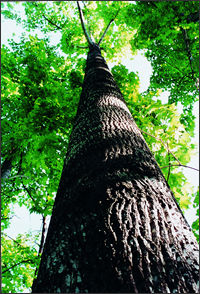|
| ||||
|
|
For more information, see www.sustainablehardwoods.info.
American hardwoods derive from managed natural forests, which have high natural bio-diversity, provide a habitat for a wide range of species, and are very resilient to fire and pests. The RPA Assessment also indicates that overall hardwood forests are getting older in the States and that this maturation is leading to increased ecosystem diversity. Fertile forest soils and favourable growing conditions in the US mean that hardwood forests are most effectively renewed through natural regeneration. Selection harvesting, involving the removal of specified individuals or small groups of trees, is typical in American hardwood forests, which offer a greater diversity of timber species than any other temperate hardwood forest resource. At a time when there is a trend towards relatively uniform plantation woods in many other parts of the world, American hardwoods continue to offer all the variety and decorative advantages of natural forest woods. Over the last 50 years throughout the US there has been a 39% increase in the amount of wood and paper products produced per cubic foot of wood input. The application of a set of internationally recognised grading rules, established more than 100 years ago by the National Hardwood Lumber Association (NHLA), has made a major contribution to waste minimisation in the American hardwood lumber industry.
All forest owners in the United States are subject to Federal legislation designed to protect habitats for threatened species and 44 States now have best management practice legislation.
| ||||||


 According
to data published as part of the US Renewable Resources Planning
Act (RPA) Assessment, over the last 50 years the inventory of hardwoods
standing in US forests increased by more than 90% as harvesting
levels remained well below the level of growth. The US hardwood
inventory now stands at 10,000 million m 3 and is growing at a rate
of more than 200 million m 3 per year (before harvesting), despite
high levels of domestic hardwood consumption in the US and record
exports.
According
to data published as part of the US Renewable Resources Planning
Act (RPA) Assessment, over the last 50 years the inventory of hardwoods
standing in US forests increased by more than 90% as harvesting
levels remained well below the level of growth. The US hardwood
inventory now stands at 10,000 million m 3 and is growing at a rate
of more than 200 million m 3 per year (before harvesting), despite
high levels of domestic hardwood consumption in the US and record
exports. The
United States operates an effective and enforced regulatory framework
to deliver sustainable forest management. Its approach to forest
regulation is adapted to a national forest environment in which
there is a well developed private industry sector with a very long
history of private forest management and a strong civil society.
Around 73% of hardwood forest land in the eastern States is privately
owned, often by fami-lies whose ownership stretches back several
generations. There are approximately four million private forest
owners with an average lot size of 50 acres. The hardwood processing
industry owns only 11% of the eastern US hardwood resource, with
the balance of 16% owned by Federal and State Governments.
The
United States operates an effective and enforced regulatory framework
to deliver sustainable forest management. Its approach to forest
regulation is adapted to a national forest environment in which
there is a well developed private industry sector with a very long
history of private forest management and a strong civil society.
Around 73% of hardwood forest land in the eastern States is privately
owned, often by fami-lies whose ownership stretches back several
generations. There are approximately four million private forest
owners with an average lot size of 50 acres. The hardwood processing
industry owns only 11% of the eastern US hardwood resource, with
the balance of 16% owned by Federal and State Governments.